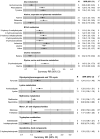Metabolomics and Type 2 Diabetes Risk: An Updated Systematic Review and Meta-analysis of Prospective Cohort Studies
- PMID: 35349649
- PMCID: PMC9016744
- DOI: 10.2337/dc21-1705
Metabolomics and Type 2 Diabetes Risk: An Updated Systematic Review and Meta-analysis of Prospective Cohort Studies
Abstract
Background: Due to the rapidly increasing availability of metabolomics data in prospective studies, an update of the meta evidence on metabolomics and type 2 diabetes risk is warranted.
Purpose: To conduct an updated systematic review and meta-analysis of plasma, serum, and urine metabolite markers and incident type 2 diabetes.
Data sources: We searched PubMed and Embase until 6 March 2021.
Study selection: We selected prospective observational studies where investigators used high-throughput techniques to investigate the relationship between plasma, serum, or urine metabolites and incident type 2 diabetes.
Data extraction: Baseline metabolites per-SD risk estimates and 95% CIs for incident type 2 diabetes were extracted from all eligible studies.
Data synthesis: A total of 61 reports with 71,196 participants and 11,771 type 2 diabetes cases/events were included in the updated review. Meta-analysis was performed for 412 metabolites, of which 123 were statistically significantly associated (false discovery rate-corrected P < 0.05) with type 2 diabetes risk. Higher plasma and serum levels of certain amino acids (branched-chain, aromatic, alanine, glutamate, lysine, and methionine), carbohydrates and energy-related metabolites (mannose, trehalose, and pyruvate), acylcarnitines (C4-DC, C4-OH, C5, C5-OH, and C8:1), the majority of glycerolipids (di- and triacylglycerols), (lyso)phosphatidylethanolamines, and ceramides included in meta-analysis were associated with higher risk of type 2 diabetes (hazard ratio 1.07-2.58). Higher levels of glycine, glutamine, betaine, indolepropionate, and (lyso)phosphatidylcholines were associated with lower type 2 diabetes risk (hazard ratio 0.69-0.90).
Limitations: Substantial heterogeneity (I2 > 50%, τ2 > 0.1) was observed for some of the metabolites.
Conclusions: Several plasma and serum metabolites, including amino acids, lipids, and carbohydrates, are associated with type 2 diabetes risk.
© 2022 by the American Diabetes Association.
Figures





References
-
- Wishart DS. Metabolomics for investigating physiological and pathophysiological processes. Physiol Rev 2019;99:1819–1875 - PubMed
-
- Fernandez C, Surma MA, Klose C, et al. . Plasma lipidome and prediction of type 2 diabetes in the population-based Malmö Diet and Cancer Cohort. Diabetes Care 2020;43:366–373 - PubMed
Publication types
MeSH terms
Substances
Associated data
Grants and funding
LinkOut - more resources
Full Text Sources
Medical
Miscellaneous

